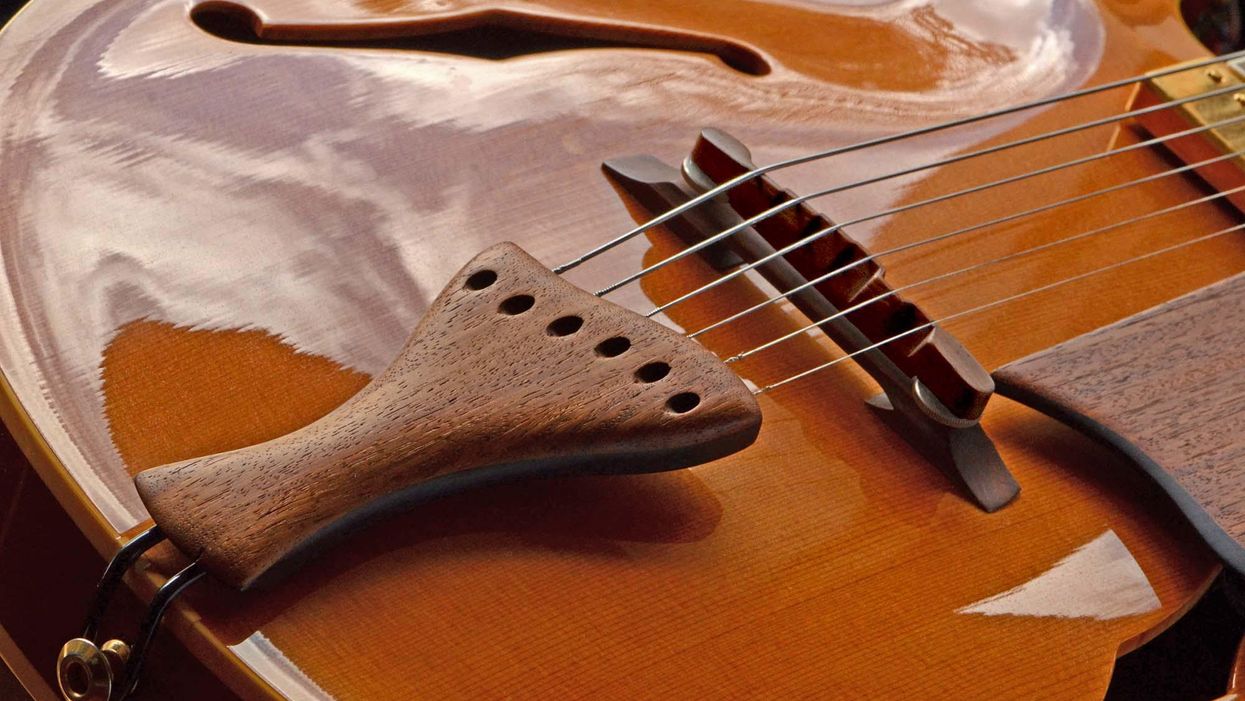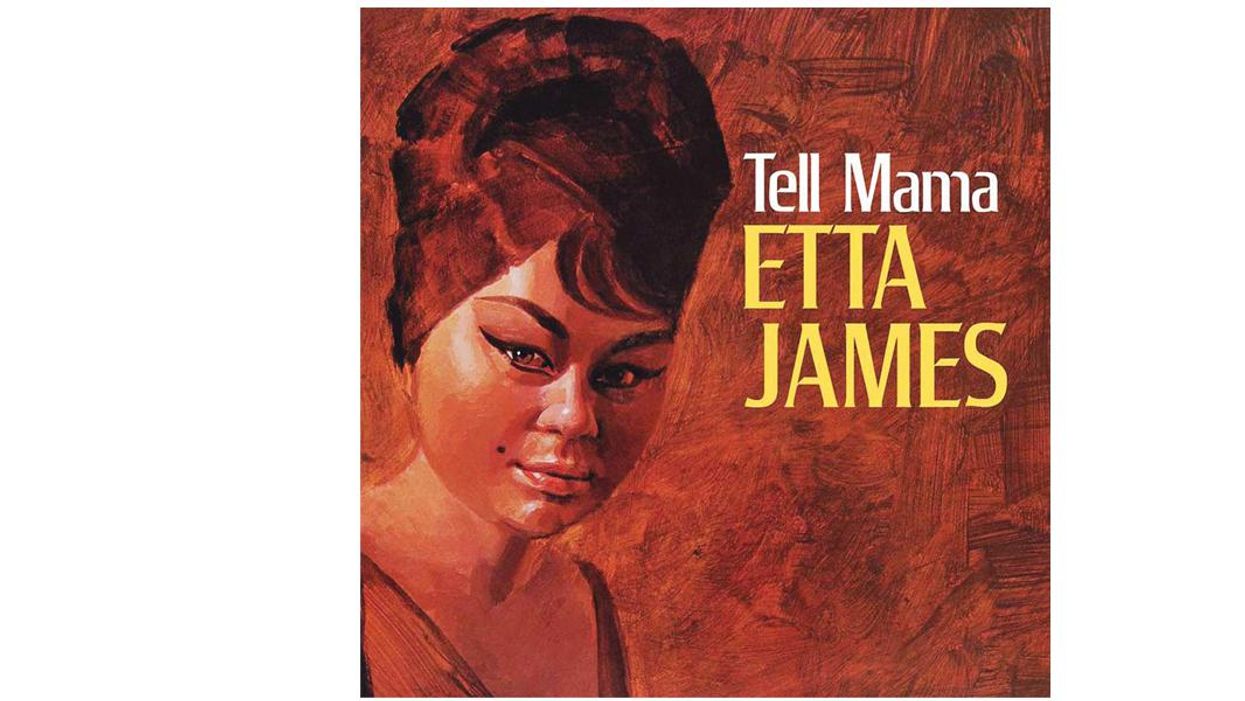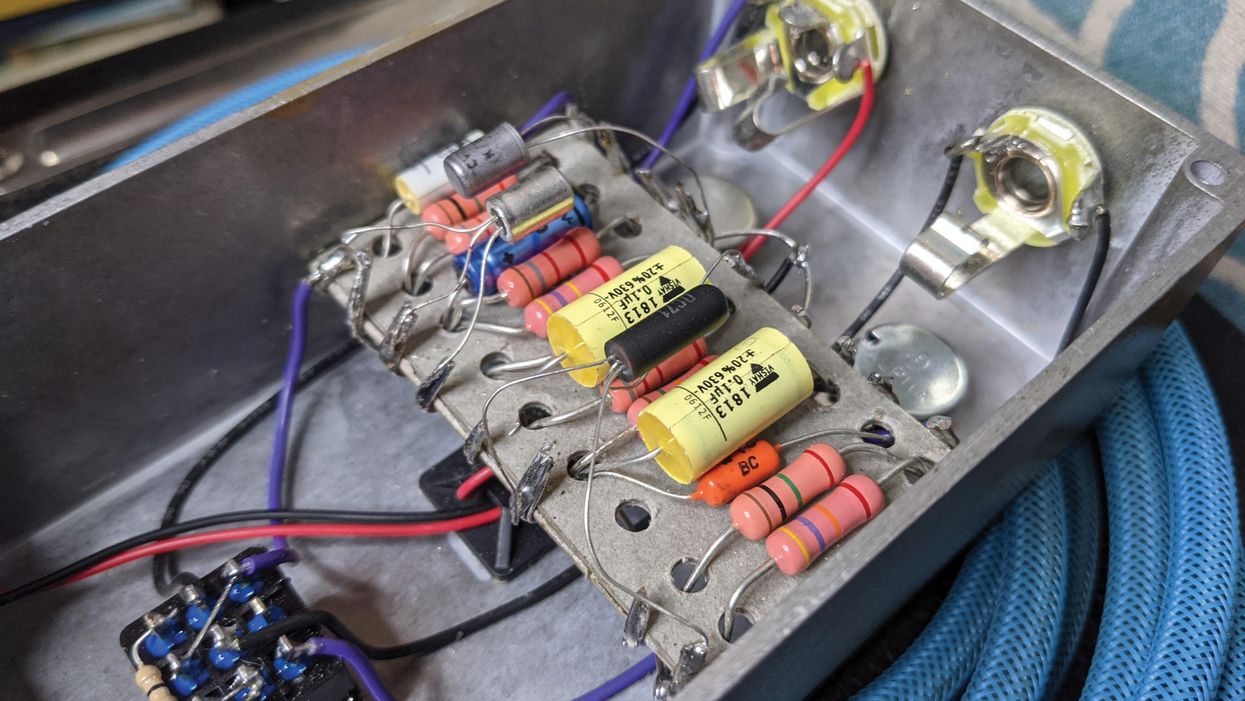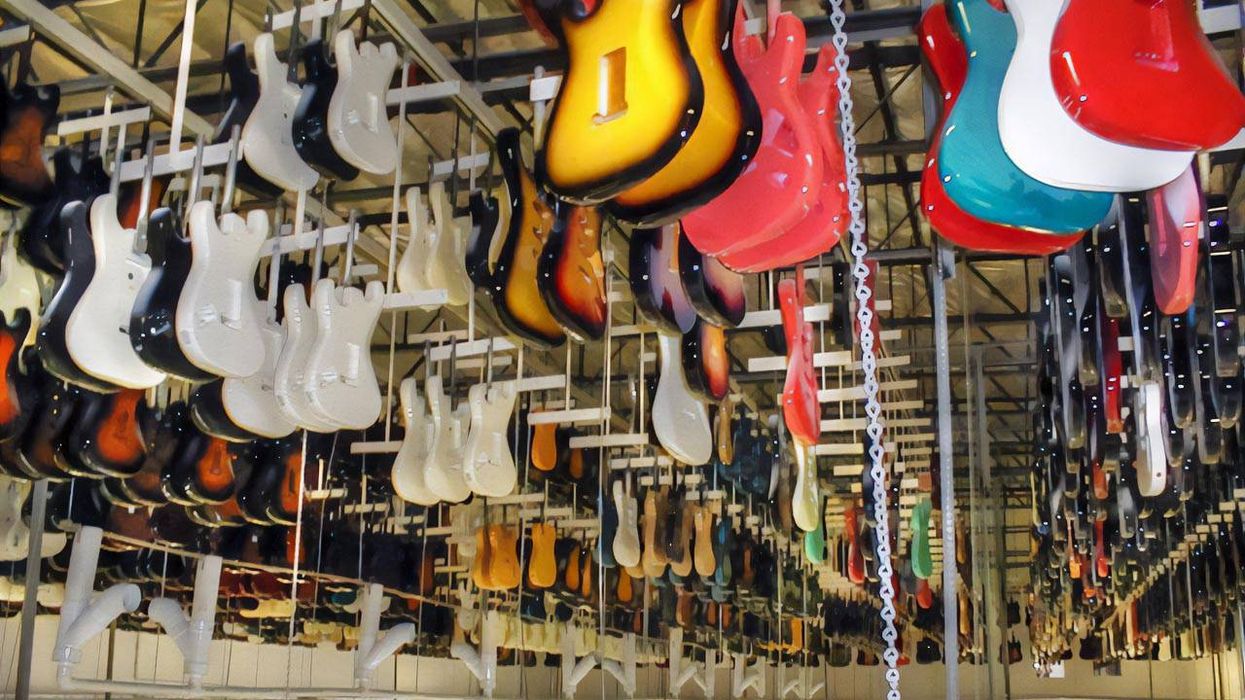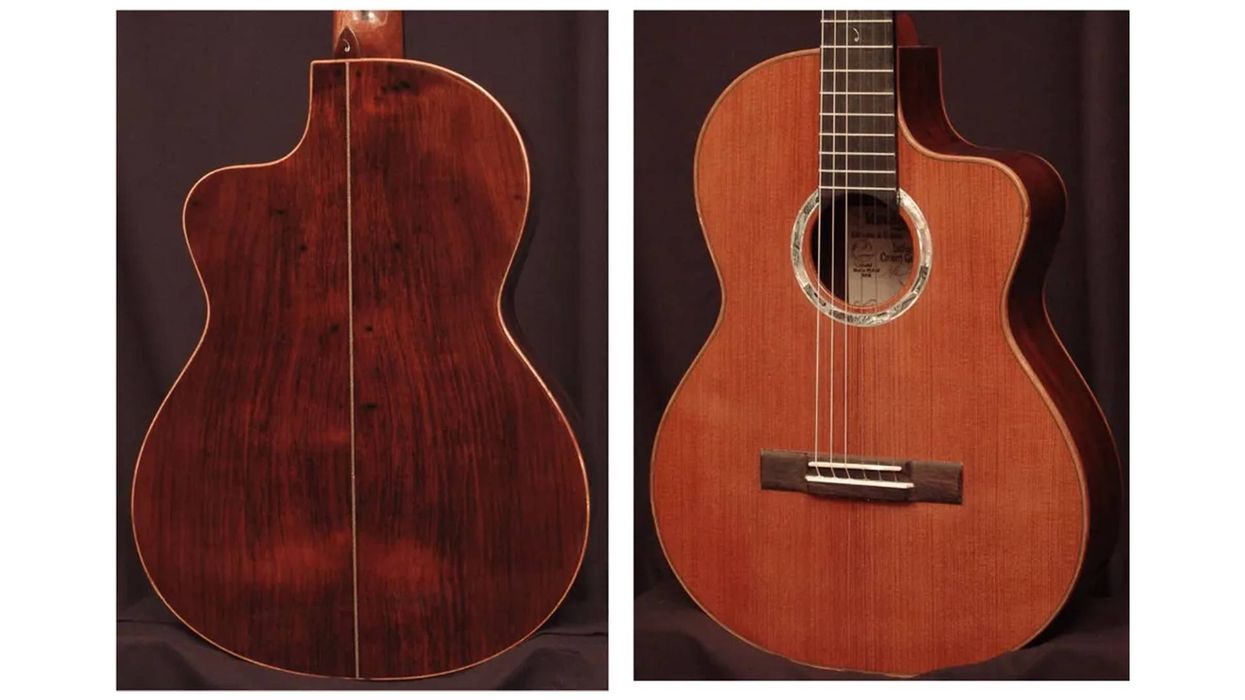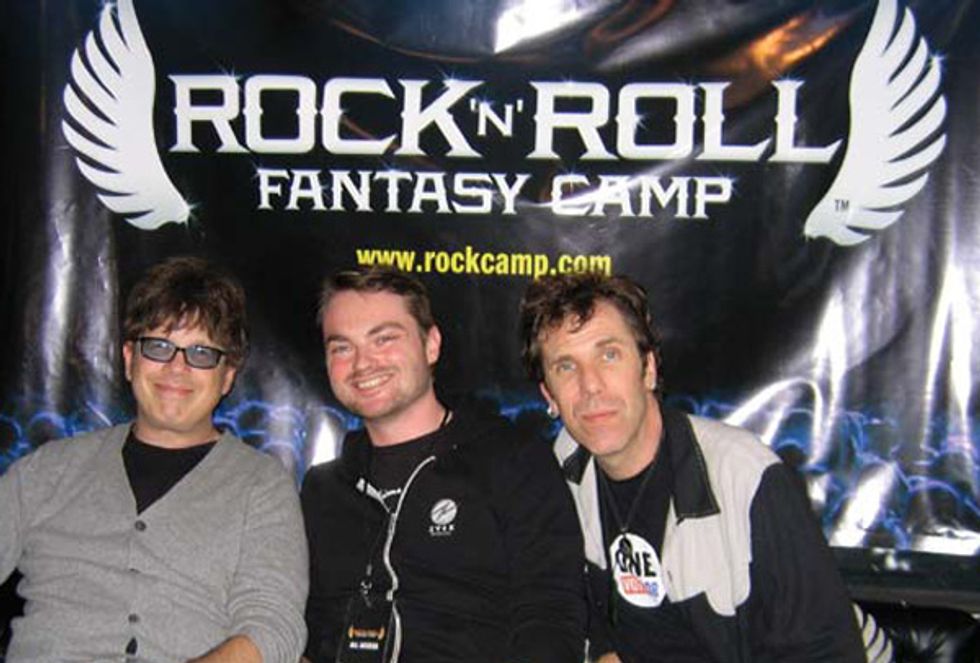 Elliot Easton, Jordan Wagner and Slim Jim Phantom. |
| Click here to see a slideshow of Rock 'n' Roll Fantasy Camp set to the song Jordan's RRFC band recorded |
“How’d you like to go jam with Steven Tyler in a few weeks?” was the question I got from a PG editor over the phone. As you can imagine, I was a bit taken aback by the proposition; I thought it was a lame attempt at a practical joke. Ready and willing to follow along with the gag, the subsequent statement put things into perspective: “We’d like to send you to Rock ‘n’ Roll Fantasy Camp.” As the details followed, I was soon overwhelmed with excitement, trying to wrap my mind around the fact that in less than a month I’d be meeting the likes of Todd Rundgren, Elliot Easton and Carmine Appice. I was going to take part in the grandest of rock daydreams.
Like many people, everything I knew about R&RFC I learned from a particularly good episode of The Simpsons. Homer and his pals participate in an actual camp with log cabins and learn how to “act” like rock stars under the tutelage of Mick Jagger and Lenny Kravitz. Not being an animated fictional character, I had no idea what was in store for me. It preyed upon my anxiety. I was going to get to hang out with legends and actually play with them? How do you prepare yourself for that?
For those who are mostly in the dark about the details, Rock ‘n’ Roll Fantasy Camp is a five-day excursion to a city well established in the popular music scene. Each camper participates in a band with other campers… and one rock star. The whole shebang concludes with a gala event on the final night at a famous music venue, where the band rocks out on the stage. R&RFC just celebrated its eleventh anniversary this year with a camp in Hollywood, CA (from April 29 to May 3).
In the past, they’ve had rock stars such as Roger Daltrey, Paul Stanley, Brian Wilson, Slash, Alan White and Jack Bruce take part. This year’s star-studded lineup promised to be phenomenal as well, with the names Bruce Kulick, Mark Hudson, Teddy Andreadis, Kip Winger, Danny Seraphine and Sandy Gennaro gracing the press release, just to name a handful. Each of these seasoned pros (dubbed “rock counselors”) was set to lead a band of campers, sculpting and shaping a handful of tunes to unleash on the final night at a sold-out show at The Whisky A Go Go.
Not only that, but each band would also get to record an original song at Capitol Studios with Eddie Kramer, the master producer and engineer who worked with Jimi Hendrix and Led Zeppelin. Last, but undoubtedly not least, each band would get to play an Aerosmith song with the legend himself, Steven Tyler, who arrived on the third day for a long Q&A session followed by a visit to the practice sessions of each of the 12 bands. He talked to the bands, listened, and jumped in to sing along while they played. And although it wasn’t in the original plan, he also made a surprise appearance at the Whisky and saw each of the bands perform on stage.
I spoke to Fantasy Camp founder David Fishof, and asked what prompted him to start it. “I was on tour with Ringo,” he told me, “and it would be me and these rockers on the plane… Joe Walsh and Levon Helm and Dr. John… I saw how amazing these guys were, you know, when they had no one around them and they were just regular musicians… not the way people always talk about rock stars. Whenever someone would ask me what it was like, I thought, ‘If I could only give this experience to people.’ I saw how much fun the rockers were having on the tour, so in ’96 I decided to share that experience, and I did my first camp in Florida. I called guys I’d met on tour, Nils Lofgren and Clarence Clemmons, Mike Love, Mark Farner, and so on. No one said no. Everyone had such a great time. For me it’s just about giving people an amazing experience, changing people’s lives through music.”
Let the feelin’ get down to your soul
As a journalist, I had just as many questions about the camp as I did a guitarist. I mean, put five total strangers in a room, tell them they have four-and-a-half days to get a few songs, including one original, ready and polished to play at a sold-out show at one of the most famous venues in the world—how is that going to happen? People who’ve played in bands will tell you it can take weeks to get a set good and tight, so this was a big worry for me. A major part of being in a band is learning how to feed off of the other bandmembers’ mannerisms and styles, and this usually doesn’t happen in the course of a week. It can take months, even years, for a band to really sound professional, and I personally wanted to sound like gold if I was going to be setting foot on the stage that Jim Morrison and John Bonham had graced with their presence.
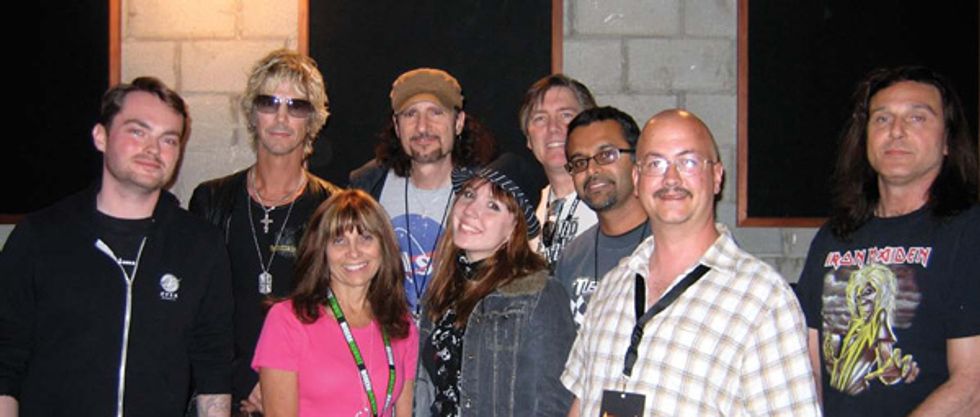 From left to right: Jordan Wagner, Duff McKagan, Francesca Bonavita, Bruce Kulick, Ally Pacella, Greg Deal, Ujesh Desai, Anthony Hixon and Jamie Nichols. |
Meeting my band was a very casual moment. I was fortunate to be in a talented group who all shared the same curiosities as me. I was introduced by Rudy Sarzo, the Ozzy Osbourne and Quiet Riot bassist, to our rock star counselor and band leader, Bruce Kulick. Knowing Bruce’s background, I wasn’t entirely sure what to expect. He played on several KISS records, and is a member of Grand Funk Railroad. His third solo record is about to come out, and features players like Gene Simmons, Steve Lukather, and Eric Singer. The man played on the Bat Out of Hell tour, for Pete’s sake! Was he going to be personable, or standoffish? Would we all be able to work well together as a team with someone who was used to playing with some of the world’s most talented musicians?
The band members came from a very diverse pool. Offering a friendly handshake, a man in military fatigues introduced himself as Sergeant Anthony Hixon, our bass player, fresh from a tour of duty in Iraq. Our lead vocalist, Ally Pacella, with an operatic voice and fantastic presence, hailed from Russia. Backing up Ally was Francesca Bonavita, who contributed vocals and also provided percussion talents. Guitar duties would be handled by me and Jamie Nichols, a hardworking rocker from Canada who shared some of my own musical tastes. Jamie was a blast to work and hang out with, and his sense of humor certainly helped ease my nervousness. Rounding out the rhythm section was not one but two drummers: Greg Deal and Ujesh Desai. These guys were a great rhythmic powerhouse, and their enthusiasm was something I considered us very lucky to have. Some of my fondest memories of the camp are of me and Ujesh geeking out over the video taken of us playing “Crazy Train” with Rudy Sarzo, and sneaking back to the practice space and playing “Master of Puppets” really badly… but we didn’t care, it was just so much fun. He was the one who came up with our band name, W.T.F.
The twenty minutes or so that we all banded together in the hotel lobby to jam on “Wild Thing” with acoustics, the drummers slapping their knees in time, was one of the highlights of the camp. It was a great bonding experience, just getting to know one another through the simple three-chord riff. Bruce wielded a beautiful Gibson Elvis Presley Dove and led us through the classic tune. It was particularly humbling (and really funny) to be drowned out by Rudy’s group a few feet away from us. Their singer was belting out the lyrics to “Metal Health” with Rudy, and us, grinning from ear to ear. This moment of us ‘normal folk’ jamming around with these guys was just a taste of what was to come.
Reachin’ for the sky and tearin’ up the ground
Some might expect a camp like this to be more laid back. People do show up expecting to rock all night and party every day, and they’re met with swift reminders that music is a labor of love (with a strong emphasis on labor). Rock ‘n’ Roll Fantasy Camp is a lot of fun, but a lot of work, too. Almost every hour that wasn’t spent eating a meal, attending a Q&A session, a master class, or sleeping was used for crafting the songs that would represent us on the final night. Bruce told us that people have attended with their minds set more on partying than on the business at hand. That’s not what this camp is about at all. According to him, it was Jack Blades from Night Ranger who got him involved in the camp: “That must’ve been four or five years ago… I had no idea what I was walking into, but as exhausting and as crazy as it was, I loved it… I believe in the whole vibe of it. It’s about the work that goes into being in a band. I think it’s wonderful.”
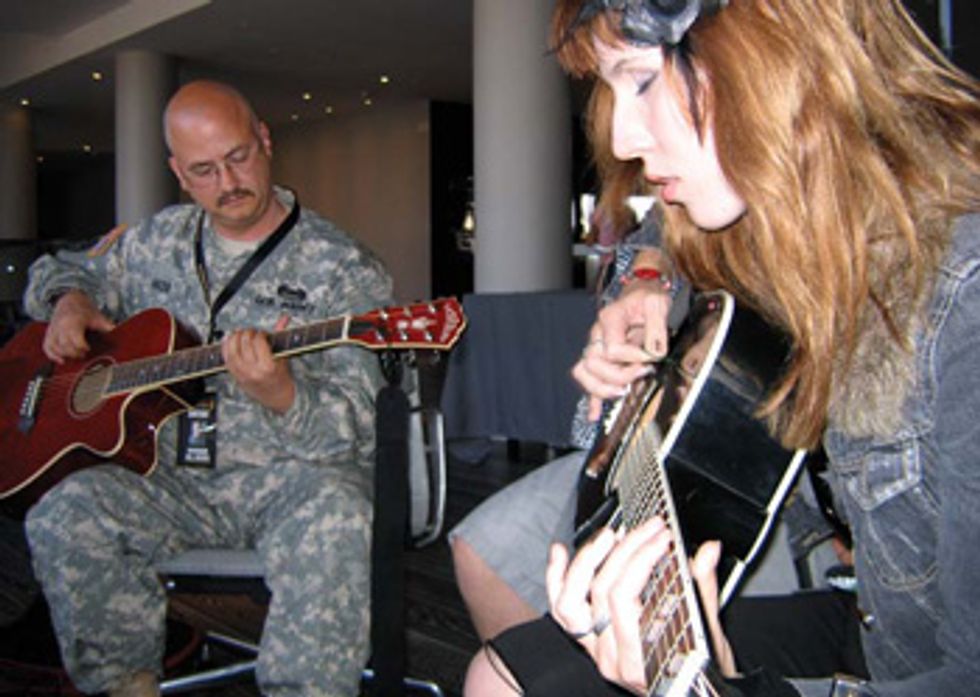 Sergeant Anthony Hixon and Ally Pacella. Sergeant Anthony Hixon and Ally Pacella. |
I quickly realized that if it’s anything, R&RFC is a five-day crash course in learning how to be in a band. This hit us almost immediately during our first practice, when we started to learn Aerosmith’s version of “Helter Skelter,” our assignment. Our bass player, Tony, was having some trouble keeping up with us. Like everyone else, Tony was came to the camp for the experience of hanging out with rock stars and getting to play at The Whisky, but he was also there to pick up on things that would help his bass playing. What I saw happen with this man over the next few days was pretty incredible. Tony was stationed in Iraq for several years, and had only tooled around with the bass a bit before he was sent to serve our country. He never really got the opportunity to keep it up, but what he did bring to the band was something that a hell of a lot of musicians out there could use: the ability to understand criticism.
In four and a half days, I saw Sergeant Anthony Hixon go from not being able to hold a pick or fret a note to keeping up with “Helter Skelter” and “Highway to Hell.” On the third day of camp, he played “Helter Skelter” for Steven Tyler. I’ve been playing guitar for over a decade, and even I was close to losing it when Tyler was standing next to me singing. I even flubbed the solo because of it. I can’t imagine what Sergeant Hixon was feeling at that moment, but he didn’t choke, even when he made a mistake or two.
This is a perfect example of why this camp is such an amazing concept. It doesn’t matter what skill level you’re on or what your background is; every artist worth their salt will tell you that you can always be better at what you do. What Tony got out of the camp was something that it takes some people years to develop, if at all: the ability to listen to the band and play when you’re supposed to. It’s a rudimentary lesson, but one of the most important any musician can master. Tony may not have mastered it, but he was certainly on his way, and doing extremely well for someone on only his third day of the job.
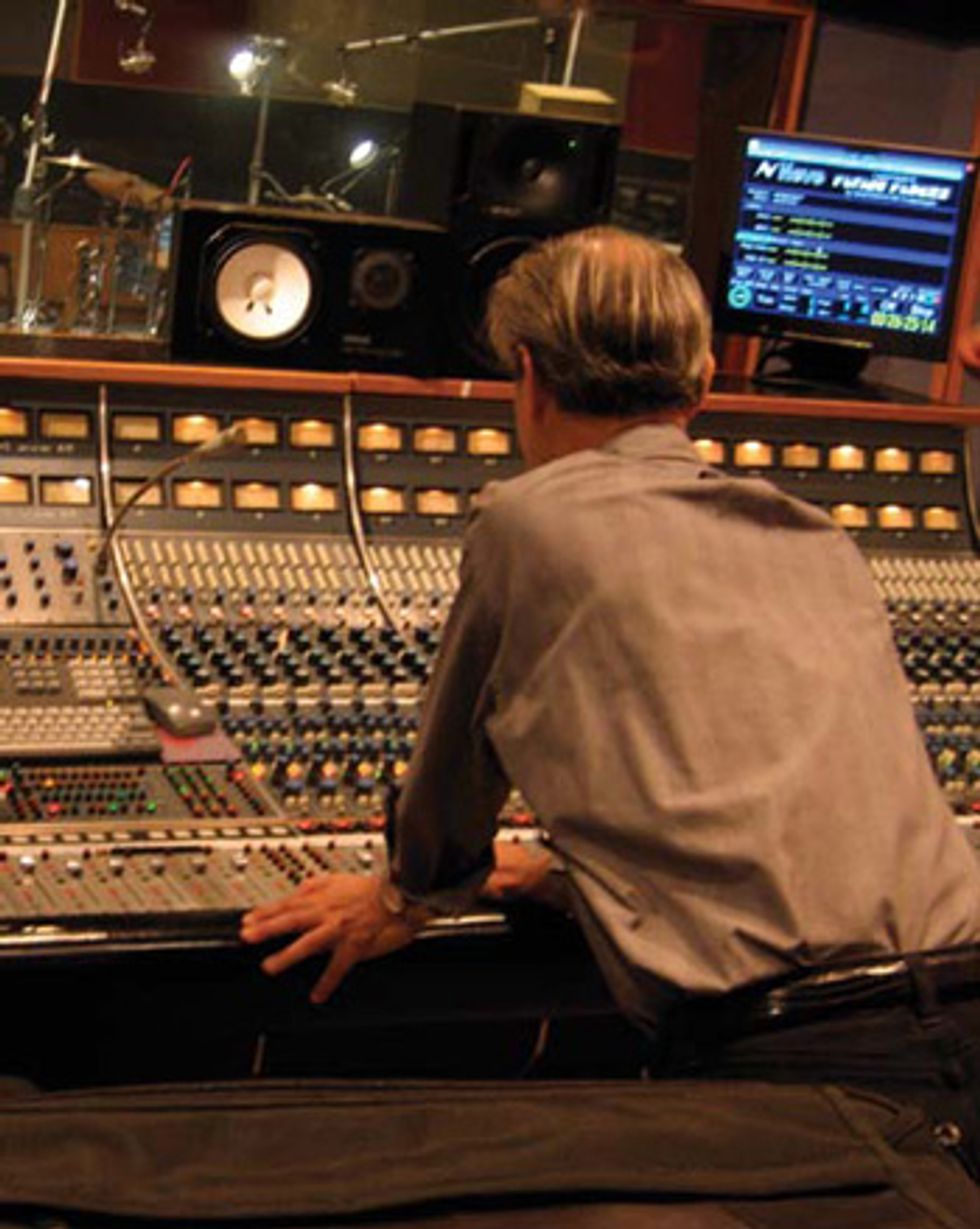 Eddie Kramer mans the board in Studio B. Eddie Kramer mans the board in Studio B. |
The day before our final night, we all piled into the van and headed up to Capitol Studios. We had been working diligently on our original song, “Livin’ Our Dream.” Ally had a guitar lick that she’d been sitting on for a while, and Bruce and the band helped turn it into a complete song. Ally wanted a song that expressed what we were all there to accomplish, and to represent what we’d be taking back with us when the camp was over. It had a cool Rolling Stones vibe to it, and our ever-helpful tour manager Leslie contributed her enthusiastic attitude to help keep the process fun and exciting.
Passing through the huge gate and entering the lobby of Capitol Studios was awe-inspiring. The multi-platinum records, portraits of The Beatles, and photos of Les Paul, Mary Ford and Frank Sinatra in the studios recording was a powerful reminder of where we were. As we passed down the long hallways, with photo after photo of music history adorning the walls, we entered Studio B and quietly watched the master himself, Eddie Kramer, working on a mix from one of the other bands. I was excited that I was about to be recorded by the man who recorded with David Bowie, Ace Frehley, Anthrax and many others. After we unpacked our instruments and arranged our positions, Eddiecame out of the control room and had us play by ourselves, offering comments in a calm demeanor. Even after decades of engineering incredible albums with some of the greatest artists ever to write a song, he clearly still knows how to have fun and keep himself firmly grounded. It made my personal experience even better when he had me play, and then grabbed the neck of my guitar and started to play a tapping solo! I had no idea what to do, except yell, “Hey Bruce! Get a photo of this!” while I goofed off and played another tapping line a string higher. That moment of hilarity was one of the best memories that I have of the camp: the time that Eddie Kramer and I did a ridiculous EVH impersonation together.
Put on the spotlights one and all
Our arrival at The Whisky A Go Go was accompanied by the strangest feeling—it was so… empty. After a moment, we were refueled by the realization that in a short time it would be packed to the brim with spectators there to be entertained. I probably spent five minutes just staring at the stage itself, reminding myself that this was where Otis Redding recorded In Person. It was pretty cool getting to walk around the place in silence, wondering what idols had sat in those comfy leather booths, and how many times Motley Crüe had gotten wasted at the bar upstairs.
When the time finally came, we were ready. The set started off just as we’d planned, ripping into “Helter Skelter,” and boy was it a rush! When I looked up after slamming that G-chord after the intro, memories of all four days rushed together all at once. It felt freaking awesome. I recall some of the shows I’ve played with my own bands as high points in my life, and this one most certainly ranked up there with them. When we closed the set with our original and then “Highway to Hell,” we knew had owned that stage, if only for a short while. Just when the moment couldn’t have gotten any more amazing, I looked up and saw ToddRundgren on stage playing with us. I mean, come on! Does it get any cooler than that? Jamie sang the closing tune and ended it with the line, “Bruce Kulick rode me to Hell!” which was hilarious. Bruce had worked Jamie pretty hard in practice, and he had to get this one in on him. It was a sign of respect and showed that he hadn’t taken it personally—he’d still had fun.
The feelings of respect and joviality were definitely shared among all the other campers, too. There were some great performances that night from all of the bands. Some of the highlights were Share Ross’s band, “Share’s Band on the Run,” whose members were all 18 or younger. Olympic ice-skating legend Scott Hamilton played some mean drums opening the event in Rami Jaffee’s (Foo Fighters) band. Teddy Andreadis’s group, affectionately named AIG (Agitators International Group), was on fire. John Martin was their vocalist and lead axeman, and this guy slayed every time I saw him play during the camp—be on the lookout for him and his trusty Les Paul in the future. All of the bands put on a great show, and really showed their confidence in the material. Watching from the balcony above the stage was Steven Tyler, observing what we had all been working on so hard since we’d jammed with him. Capping off the night was an all-star jam that filled the stage with the counselors from the show, and several of the campers dancing to the tunes alongside them. It seemed that even after five grueling days of traveling, meeting and greeting, recording, and practice, practice, practice that the campers weren’t ready for the ride to be over. If anything, the looks on their faces gave the impression that if given the opportunity, they’d have stayed another day or two.
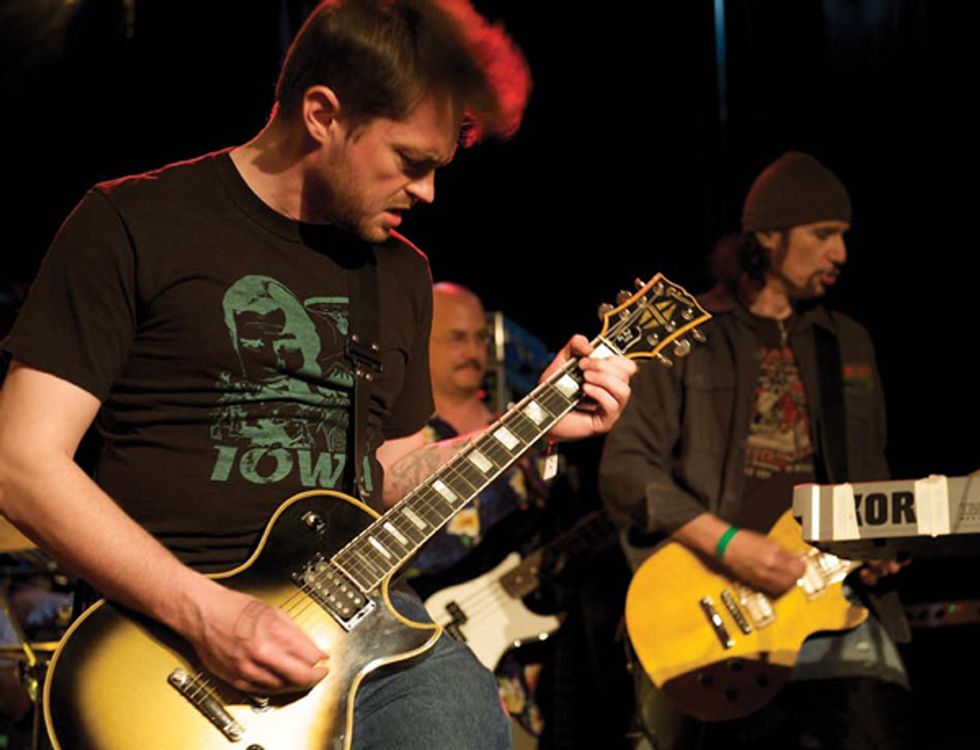 Jordan Wagner, Anthony Hixon and Bruce Kulick layin’ it down. Photo by: Alan M. Poulin / alanpoulinphoto.com. Jordan Wagner, Anthony Hixon and Bruce Kulick layin’ it down. Photo by: Alan M. Poulin / alanpoulinphoto.com. |
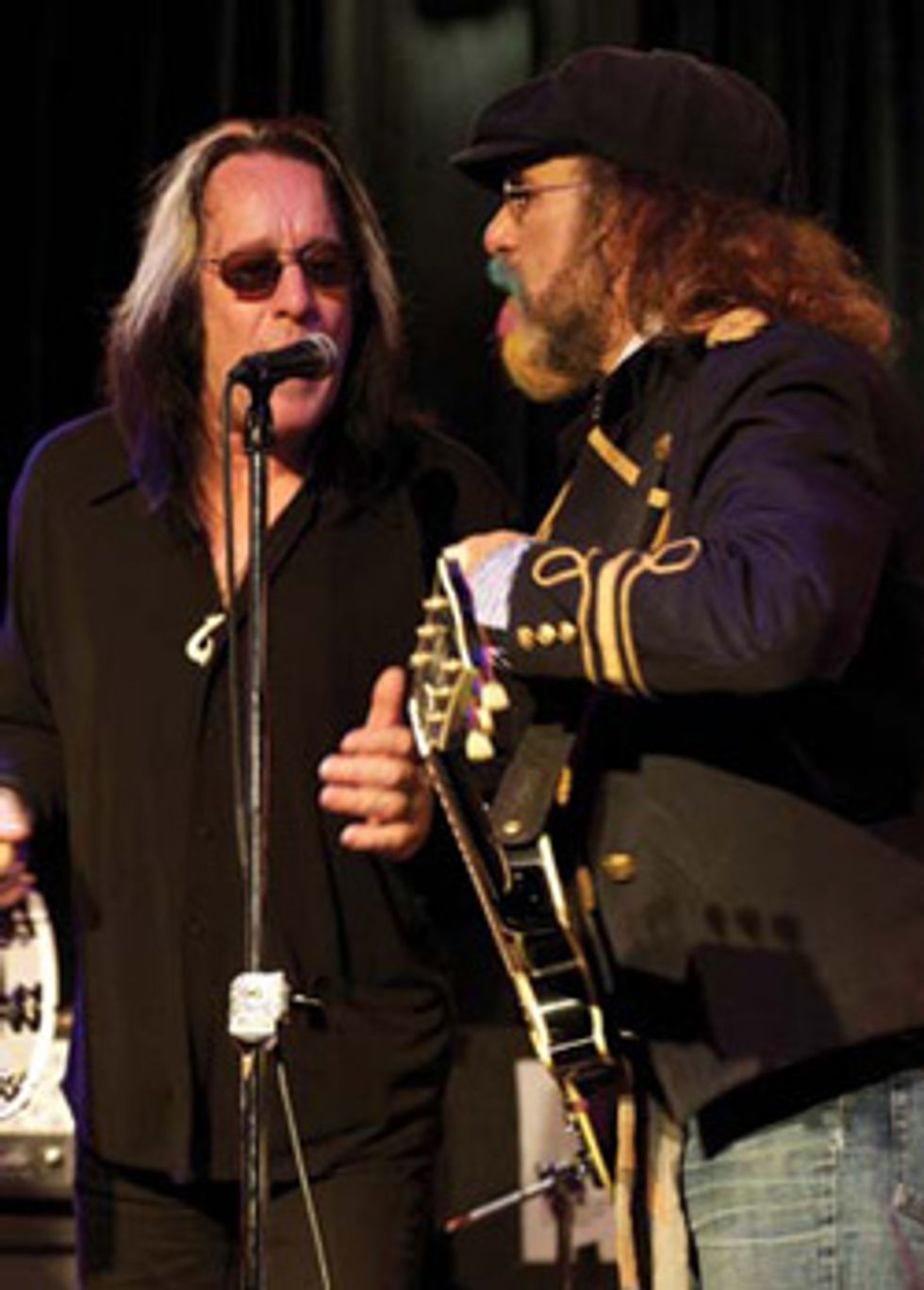 Todd Rundgren and Mark Hudson. Todd Rundgren and Mark Hudson. Photo by: Alan M. Poulin / alanpoulinphoto.com |
It’s difficult to sum up the experience that I had at Rock ‘n’ Roll Fantasy Camp, but take it from me: everybody and anybody can walk away from this camp with something new and inspiring, no matter what your skill level is. One of Fishof’s goals is to makeeasier for anybody to participate, and he’s currently working on plans to make the event more affordable and convenient to attend. Fishof explained that one of the biggest obstacles in getting people into the camp is fear: people are afraid of the unexpected and doubt their own abilities. Hearing Bruce Kulick talk about how incredible it had been for him to share a stage with Jack Bruce, I realized at that moment what I’d gotten out of this was the confidence that I could indeed work with anyone, that I didn’t have to be intimidated. All the things I got to do during those days, with the amazing people there—that’s more overwhelming than any single moment the camp had to offer. We met the challenges of working as a band in only a few days, recorded at one of the most famous studios in the world, and played on a legendary stage with some of the greatest musicians alive today. Upcoming camps will be held this fall, also in Hollywood, and next spring in London, where campers will get to record at the legendary Abbey Road Studios.
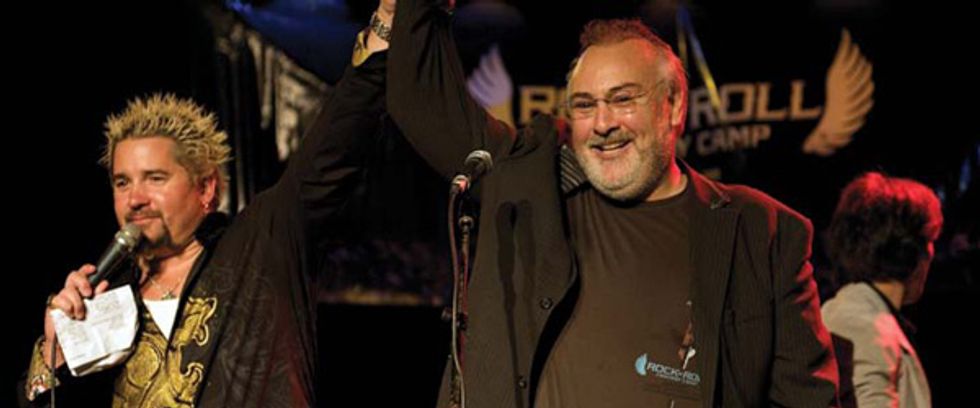 Rock ‘n’ roll master chef Guy Fieri and David Fishof. Photo Credit: Alan M. Poulin / alanpoulinphoto.com. Rock ‘n’ roll master chef Guy Fieri and David Fishof. Photo Credit: Alan M. Poulin / alanpoulinphoto.com. |




